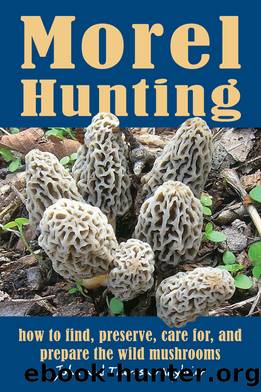Morel Hunting by John Maybrier

Author:John Maybrier
Language: eng
Format: epub
ISBN: 978-0-8117-0834-0
Publisher: Stackpole Books
The fan shape of an elm tree.
Once we shared a spot with a close friend, who broke the cardinal rule and told a friend of hers. The third party hunted our spot and came across a very old, very large elm tree that was dying. They found so many morels and, feeling guilty, called our friend to join in the hunt. They couldnât pick all of them before it got dark, so our friend, also feeling guilty, called and told us to pick them. The next morning we went to find the tree. It was a classic scenario. In three days we picked well over four hundred morels under the limbs of that very old elm. The next year we found around fifty morels. We no longer hunt that area because too many people have heard about it, but the last time I checked the tree, all the big limbs had broken off and the trunk was all but fallen over. Classic! As described, a tree will have a large fruiting of morels the first year that it is dying, followed by a year with half as many morels, and even fewer, if any, the third year. If you share a spot, your friend will tell someone, that person will tell someone, and before you know it, too many people know.
White Bark Trees
Birch, Poplar, and Aspen Trees
Birch, poplar, and aspen trees have a great deal in common, including their relationships with morels. Poplar trees are more common in northern states, whereas birch trees can be found throughout the United States. Aspen trees are more common in the western states and at high elevations. They all have shallow root systems and grow in the hills as well as damp areas and along the waterâs edge. Their bark is white, gray, or peach colored and often peels away from the trunk horizontally. They all have small, round leaves that flicker in the least breeze. Itâs helpful to check out all the different types in a tree identification book. Northern gray poplars look like they have bands with eyeballs running around the trunks. River birch have peach-colored bark and are common along rivers into the central states, whereas paper birch bark is bright white with horizontal banding tipped in black. It often grows in large stands in the northern states and Canada. Look near aspen trees for morels in mountain regions.
We have occasionally had the privilege to hunt some private land in northern Missouri, twice in the prime season. Beautiful river birch trees grow along the creek that runs through the middle of the property. The pale coral-colored bark stands out against the green and blue background. These trees deposit a lot of organic materialâbark, leaves, and sticksâthat needs to decompose. We have found some of the most exquisite gray morels under and near these trees, even when some of them do not appear to be dying. Itâs possible that flooding or all the debris may encourage the morels to fruit.
Download
This site does not store any files on its server. We only index and link to content provided by other sites. Please contact the content providers to delete copyright contents if any and email us, we'll remove relevant links or contents immediately.
| Cacti & Succulents | Flowers |
| Mushrooms | Trees |
Sapiens: A Brief History of Humankind by Yuval Noah Harari(14258)
The Tidewater Tales by John Barth(12610)
Mastermind: How to Think Like Sherlock Holmes by Maria Konnikova(7234)
Do No Harm Stories of Life, Death and Brain Surgery by Henry Marsh(6891)
The Thirst by Nesbo Jo(6834)
Why We Sleep: Unlocking the Power of Sleep and Dreams by Matthew Walker(6620)
Life 3.0: Being Human in the Age of Artificial Intelligence by Tegmark Max(5479)
Sapiens by Yuval Noah Harari(5297)
The Longevity Diet by Valter Longo(5021)
The Body: A Guide for Occupants by Bill Bryson(4978)
The Rules Do Not Apply by Ariel Levy(4870)
The Immortal Life of Henrietta Lacks by Rebecca Skloot(4528)
Animal Frequency by Melissa Alvarez(4399)
Why We Sleep by Matthew Walker(4364)
The Hacking of the American Mind by Robert H. Lustig(4319)
Yoga Anatomy by Kaminoff Leslie(4310)
All Creatures Great and Small by James Herriot(4237)
Double Down (Diary of a Wimpy Kid Book 11) by Jeff Kinney(4209)
Embedded Programming with Modern C++ Cookbook by Igor Viarheichyk(4111)
